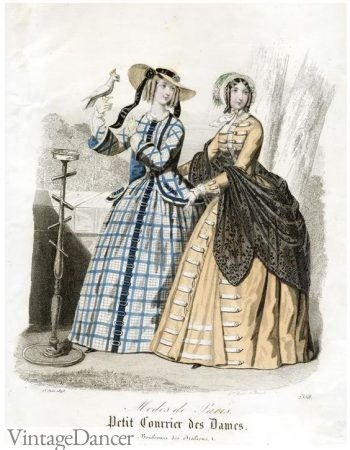High fastening and tight fitting frock coats were also very fashionable. Modish and symbolic use of working-class dress entered general consumption in various ways and in general over the last three centuries.

Working Class Victorian Life Witness2fashion
Tradition and the working class 18501950.

. The hair is worn in a simple bun at the nape of the neck higher in the 1840s and lower in the 1850s and 1860s. The author has graciously shared with readers of the Victorian Web this passage from the second edition of her Fashion in Costume 1200-2000 2000 published by A C Black Publishers Ltd which retains copyright. Overall fashion emphasized and highlighted an expansive width Ashelford 191.
They normally wore mole-skin trousers and donkey jacket- style short coats which I think were known as pea jackets or pilot jackets in those days. Skirt is unlined turned back cuffs with ruffle and double ruffle at top of sleeves worn cuffs. As found with the entire center front with vertical tear other smaller tears as seen with many old mends and scattered holes.
Please share how this access benefits you. Top hats were worn by the upper classes and bowler hats were worn by the working class. 1860s cocoa.
Introduced in 1856 the hoop skirt greatly altered the silhouette of the womans wardrobe. Designs ranged from the standard gigot which was full to the wrist to. 1850s Braided Hairstyle Tutorial.
Source for information on Working-Class Dress. The typical skirt of the 1850s was still dome-shaped. Paris remained the arbiter of fashion.
During the early 1850s the common daydress had a very short underarm seam a shallow rounded dip at the waistfront and a soft and full fan bosom. The hoop was popular almost universally and was worn by ladies maids the middle class and. Readers wishing to obtain the book can e-mail the following address.
By 1850 the cotton linen and woollen trades were fully mechanised in England. All original front hook eye closure with white cotton inner bodice with deep front stays. Ad Best Deals On 1850 Fashion.
By 1855 the cage crinoline or hoop had swayed on to the scene. Members of the working class rely exclusively upon earnings from wage labour. The sleeve was by far the most significant element of fashion.
Skirts expanded to their maximum size. International Labor and Working Class History 42. Victorian Edwardian Working Class Clothes.
Ad Shop Top-Quality Authentic Styles Enjoy Great Prices Service Delivery. When history emerged as a scholarly discipline in British universities at the end of the 19th century it rarely took. See more ideas about historical clothing historical fashion historical dresses.
A North London street 1950s. WORKING-CLASS DRESSFor much of the period between the eighteenth century and the present most people in western countries could be characterized as working class. Men styled their facial hair into mutton-chop sideburns and mustaches.
The sack coat would later become the modern suit coat. Thus according to more inclusive definitions the category can. The neckties would have been worn as sweat rags particularly during the great days of railway construction during the 1840s and 1850s.
Your story matters Citation Cohen Lizabeth. The bowler hat was invented around 1850 but was generally seen as a working class hat while top-hats were favoured by the upper classes. Milliners created hats for the elite as well as the middle class.
Masculine styles began to originate more in London while female fashions originated almost exclusively in Paris. It gave relief from the weight of numerous petticoats and from the plethora of undergarments that needed to be washed. Gigot or leg-o-mutton sleeves reached an apex in size between 1830 and 1833 and many varieties appeared Byrde 39.
Though a new style called the sack coat a thigh-length loosely fitted jacket became popular. The working class comprises those engaged in manual-labour occupations or industrial work who are remunerated via waged or salaried contracts. In 1800 working-class people wore linen underwear men wore woollen outer clothing and women wore cotton linen and woollen dresses.
Women were delighted to wear the cage. Rose Bertin 1744 - 1813 was the first internationally known milliner who worked out of Le Grande Moghul in Paris making hats for the nobility and upper class. Working Clothes and Fashion.
Working-class occupations include blue-collar jobs and most pink-collar jobs. The most notable contribution to 1850s fashion however was the hoop skirt. Emma Griffin charts the postwar emergence of working-class history as a scholarly discipline and argues that thanks to the torch-bearers the rationale for it has ebbed away.
Many occupations and styles of living are encompassed ranging from independent skilled artisans in regular work to unskilled laborers or the unemployed. Mar 19 2016 - Explore Bec Banhams board Victorian Working ClassLower Class Clothing 1840-1860 followed by 181 people on Pinterest. 1850s fashion in Western and Western-influenced clothing is characterized by an increase in the width of womens skirts supported by crinolines or hoops the mass production of sewing machines and the beginnings of dress reform.
Suits had high stiff collars and were decorated with large bow ties. However the waistcoats seem to have been universal. There has been a significant flow of garment types and textiles from utilitarian and.
Victorian working women seemed to prefer blue skirts and blue aprons- My Pinterest Board. Tradition and the Working Class 18501950 The Harvard community has made this article openly available.

1840 1849 Fashion History Timeline

94 Victorian Working Class Lower Class Clothing 1840 1860 Ideas Historical Fashion Historical Clothing Historical Dresses

87 1850s 60s Working Class Impression Ideas Civil War Dress Civil War Fashion Historical Clothing

1840 1850s Fashion Costumes Dickens Victorian Costuming
1850s In Western Fashion Wikipedia

Working Class Victorian Life Witness2fashion

Stitching The Fashions Of The 19th Century Who Dressed The 19th Century Elite

0 comments
Post a Comment